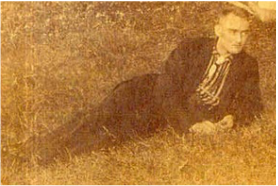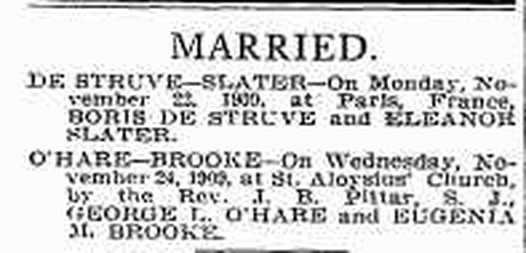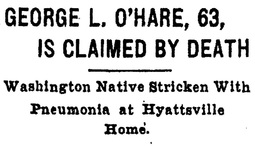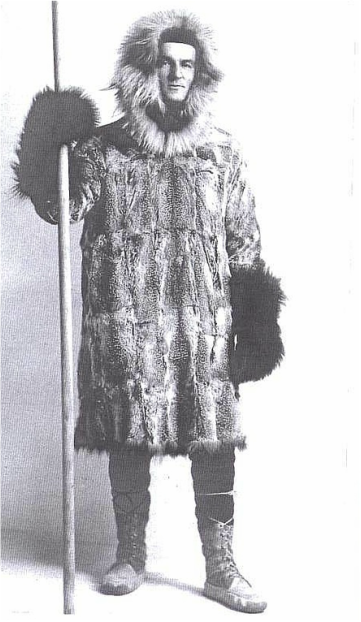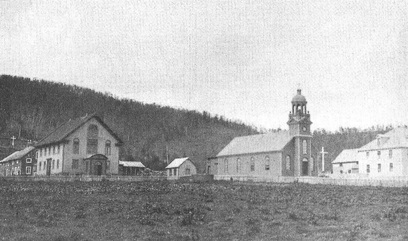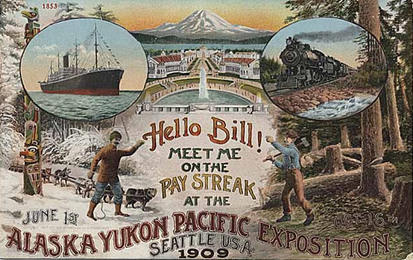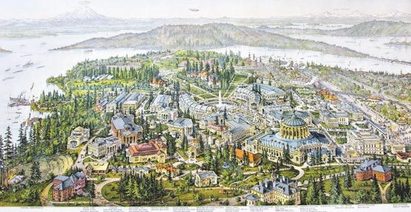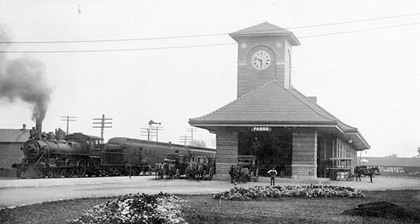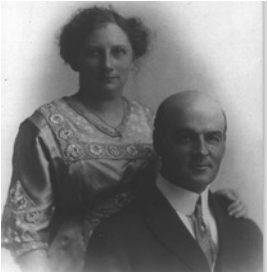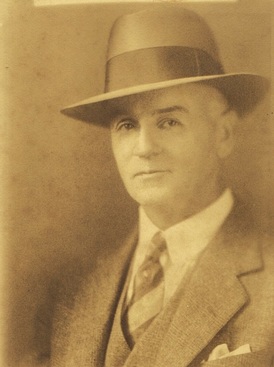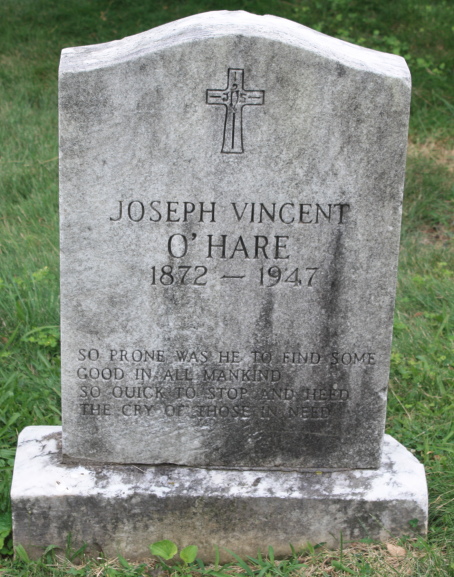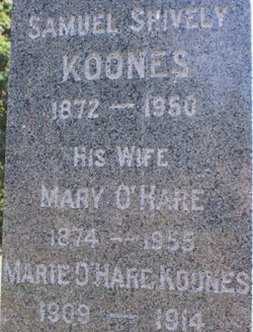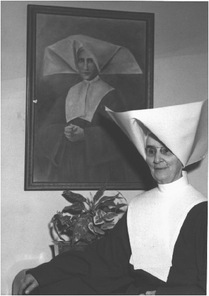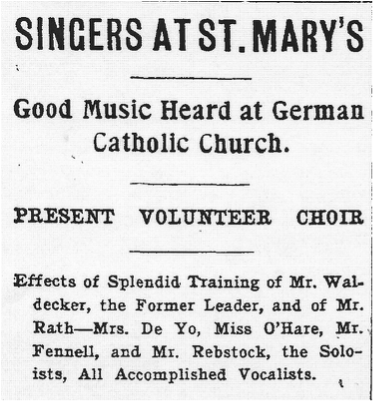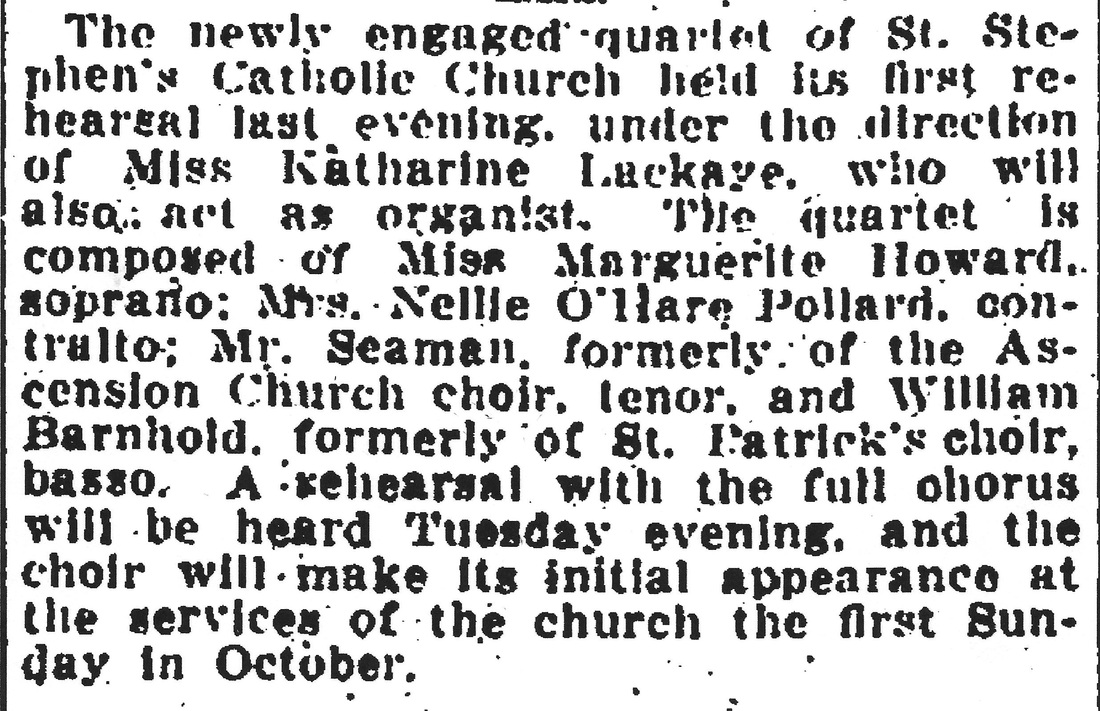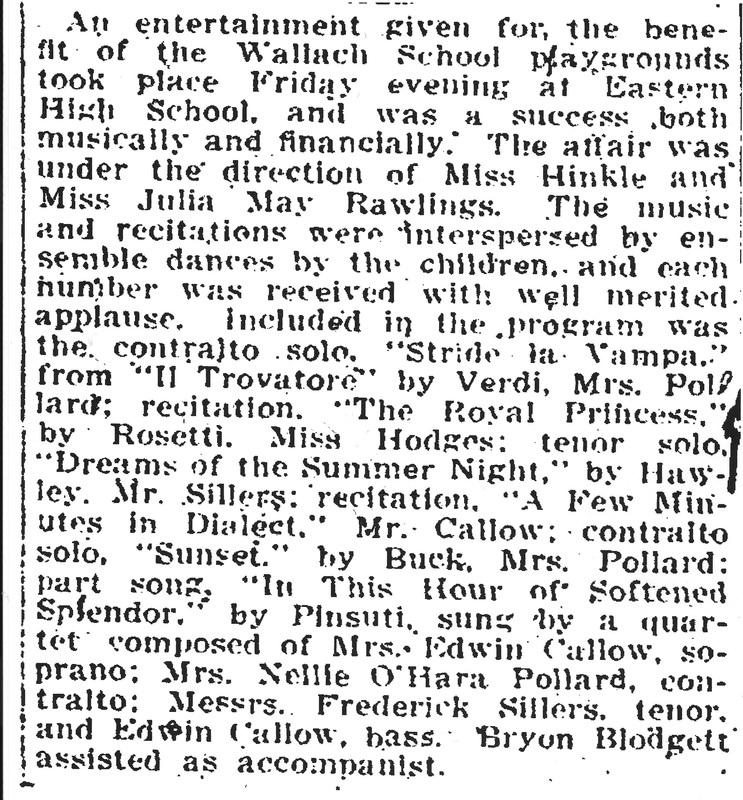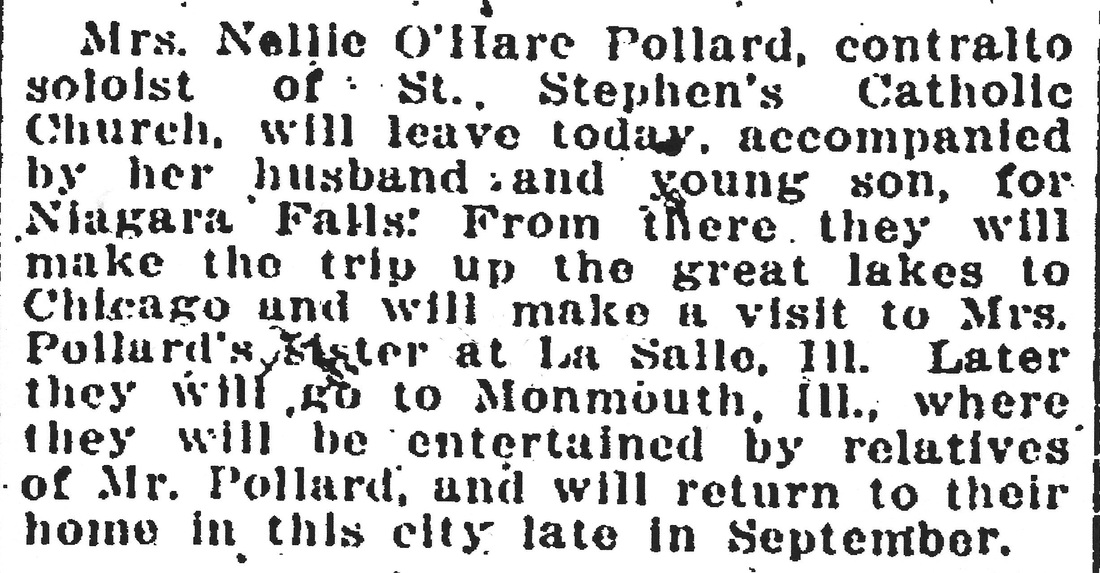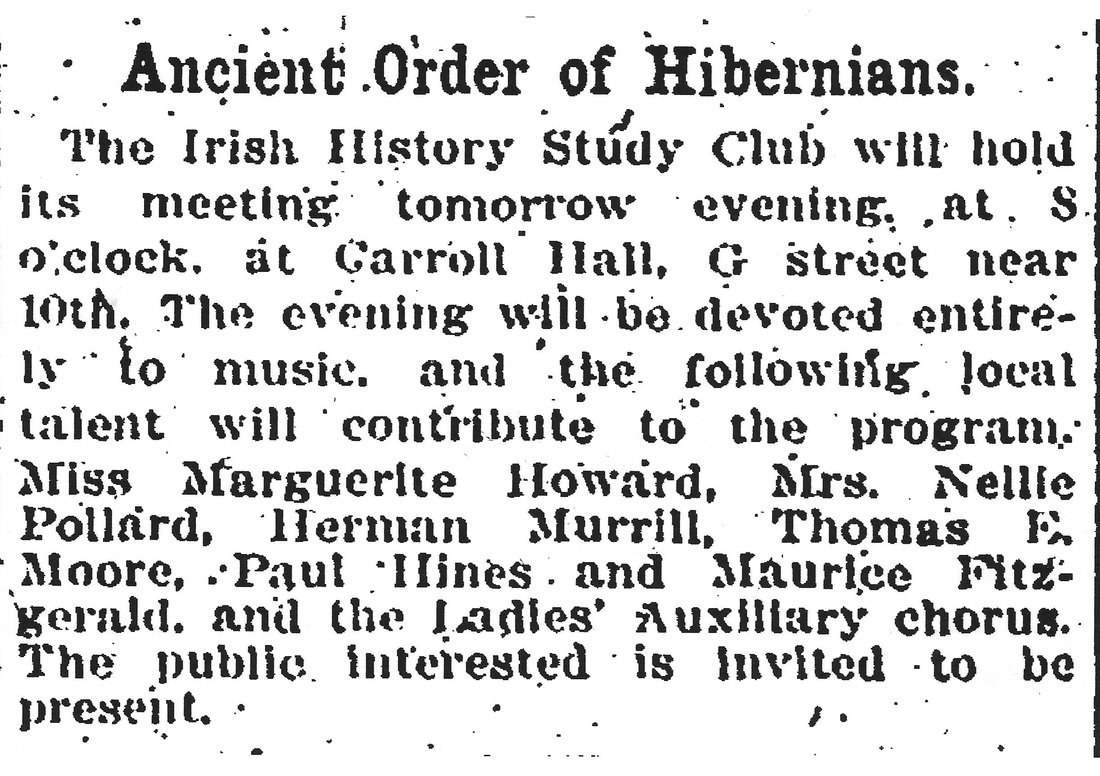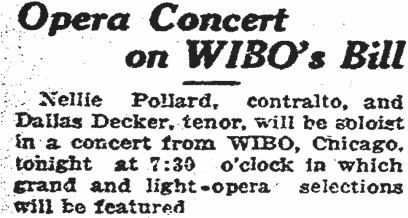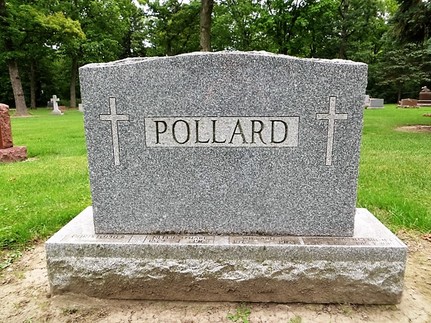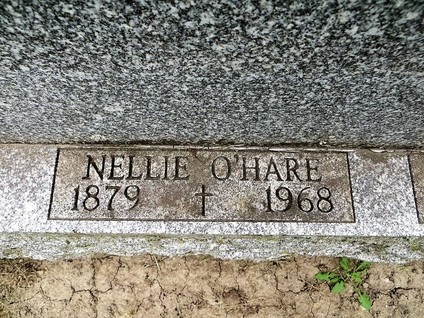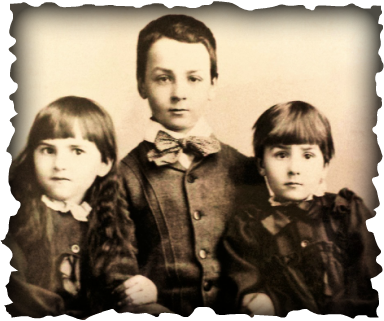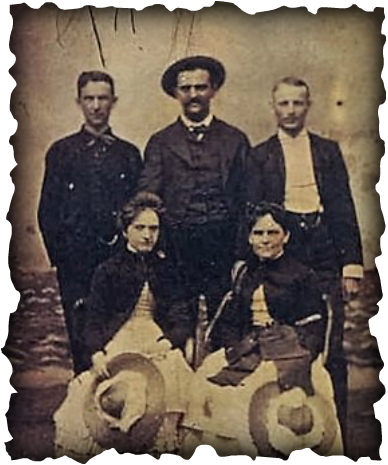Upon the death of their mother, Eva Brown O'Hare, the O'Hare siblings were divided among their father and their two sets of grandparents. William Christopher stayed with his father while his younger siblings were arbitrarily separated into two groups based on hair color--the blonds and red heads going to one set of grandparents and the brunettes to the other.
George Longdon O'Hare (1871-1934)
|
When William Christopher O'Hare left Washington, D. C. for Shreveport to pursue a music career rather than work in the family business, second son George Longdon seems to have taken his place.
The 1888 and 1890 Washington, D.C. directories show George living with his father and working as "clerk," likely in the family grocery business. The 1900 census reveals that he was living again at Linden Grove, working as a "grocer/salesman." |
In 1909, a Jesuit priest married George Longdon and Eugenia M. Brooke. The couple had two sons, George Joseph and John Brooke.
By 1910, George was working as a salesman with no further specifics indicated. By the 1920 census, he was a clerk with the War Department, and by 1930 a collector for a law firm.
|
After twenty years in Hyattsville, MD, George Longdon O'Hare, 63, died of pneumonia at Washington Sanitarium, Takoma Park, Maryland, on April 11, 1934. He was buried in the O'Hare family plot at Mount Olivet Cemetery, Washington, D. C.. Survivors included wife Eugenia M. Brooke O'Hare and two sons, George Joseph and John Brooke, all of Hyattsville.
|
Joseph Vincent O'Hare (1872-1947)
|
As a young man, Joseph Vincent O'Hare joined a group of French and Italian Jesuit priests as a lay brother at the Holy Cross mission school in the Alaskan interior. The mission, which ministered to and taught Ingalik (Athabaskan) people, had been founded in the 1880s by Father Aloysius Robaut. In 1912, the town adopted the name Holy Cross after the mission.
According to the 1900 U.S. census for Alaska, in which O'Hare appears as lay brother and teacher, approximately 75 students boarded at the school. Brother Joseph Vincent O'Hare appears briefly in the 1900 Alaska-Klondike Diary of Elizabeth Robins, an American actress who traveled in search of her brothers and met O'Hare in St. Michael's, Alaska, during his rare trip away from Holy Cross. Having met Robins' brothers and seen a cabin where they had lived, O'Hare provided what information he could, and Robins used his description of her brothers' cabin in her novel The Magnetic North. In the process of talking with her, he mentioned the many deaths at the mission, the most recent of the Mother Superior, and reveals his fear that more deaths may have occurred during his absence. Robins describes O'Hare as a "young man of quite the middle class with a trace of the Irish in his speech." She writes that he said he "was meant to be a priest" but that his "health broke down," and he had to give up the idea and settle for becoming a Brother. Unlike Brothers in the mainland, he wasn't confined to manual labor and, instead, served as a teacher. |
|
Robins' diary further reveals the hardship and psychological effect of mission life as she writes that O'Hare "thought longingly sometimes of his house--the life was so hard and the ingratitude so flagrant it threatened to sour one." She explains that he hadn't been away from Holy Cross for four years until his trip to St. Michael's where she met him.
In an autobiographical short story titled "Rip Van Winkelized in Alaska," shared with me by one of his descendants, Joseph Vincent described a missionary's fear of returning to a modernized society that has left him behind:
Clarence, thou has tarried too long in the wilderness. Thou art even now asleep, dead asleep, and even as of old on Van Winkel's farm, are the dead leaves of forgotten things flaking o'er thee. Arise, Van Winkel of Alaska, arise. Some secret, dormant white man instinct is stirring in his soul and the slumbering form of Clarence grows uneasy. . . . |
If Joseph Vincent had been away 20 years like Rip Van Winkle and returned in 1909 as the story and official records indicate, he had been away from approximately age 18 to 38.
He reappears in the 1910 U.S. Federal Census for Washington, D. C. as a boarder, working as a solicitor for an insurance company. City directories from 1911-1917 show that he was soon working at the Library of Congress.
He reappears in the 1910 U.S. Federal Census for Washington, D. C. as a boarder, working as a solicitor for an insurance company. City directories from 1911-1917 show that he was soon working at the Library of Congress.
|
While at the Library of Congress, he married a long-time friend, the girl across the street, Sarah Nina Brown. In 1915, Joseph Vincent and Sarah Nina had a daughter, Nina Marie, who married and gave birth to twelve children, the majority of whom live in Maryland or Virginia today.
Among them and their children are a church organist, a keyboardist in a traditional jazz band, a flutist in a Massachusetts community-based band, a singer in a rock group, and several others with greater than average musical talent. Joseph Vincent's September 9, 1918 draft registration and the 1920 U. S. Federal Census list his occupation as clerk for the Carnegie Endowment. City directories indicate that this was the Carnegie Endowment for Peace. The 1930 census indicates that he had gone into real estate. |
His 1947 obituary adds a few career details, specifying that his Library of Congress job was in the copyright office and that he had also worked for the New Deal's National Recovery Administration (NRA) before opening O'Hare Estates, his real estate agency.
|
Joseph Vincent O'Hare died on August 17, 1947, approximately 14 years after Sarah Nina's death. Both are buried at Rock Creek Church Cemetery near the ancestral home, Linden Grove.
The epitaph on Joseph Vincent's headstone attests to his humanity: So prone was he to find some good in all mankind, so quick to stop and hear the cry of those in need. |
Little is known of William Christopher O'Hare's next three siblings, all sisters.
Mary Ellen O'Hare (1874-1955)
|
Born in 1874, roughly seven years after her oldest brother William Christopher, Mary Ellen married Samuel Shively Koones at Linden Grove on June 22, 1898. Samuel Koones worked fifty years for the Capital Transit Company and retired as senior receiver in the treasurer's office.
The couple had two daughters, Catherine Shively Koones (Mrs. Andrew McLaughlin) and Marie O'Hare Koones. Marie died tragically at age 4 after being struck by a car in front of the family home. Mary Ellen O'Hare Koones was a member of the Captain Molly Pitcher chapter of the D.A.R. and served as a chapter officer. Although belonging to a different chapter, Mary Ellen thus followed in the footsteps of her aunts Ann Elizabeth and Laura Christine O'Hare, who belonged to the Our Flag chapter. |
Mary Eva/Evelyn O'Hare (1876-1924)
Named for her mother, Mary Eva joined the Sisters of Charity as Sister Adele. In 1910, she was teaching at St. Mary's Orphan Asylum, Norfolk Virginia, and in 1920 at a Catholic girls school in Richmond.
She died in 1924, age 47, at Washington, D. C's Providence Hospital. |
|
Ellen "Nellie" Theresa O'Hare (1879-1968)
William Christopher O'Hare's youngest sister Nellie was active in Washington, D. C. music circles, frequently performing at social and church functions. She was (or had been) a student of Arthur W. Porter, well-know basso and teacher in the District of Columbia.
Several sample newspaper items, dated between 1901 and 1907, appear below. They are a small sample of the many articles mentioning Nellie's singing career.
The Alumnae Association of the Immaculate Conception Academy held its regular meeting on last Monday evening. . . Miss Nellie O'Hare sang "The Lost Chord." The Washington Saengerbund held its third musical entertainment of the season last evening at the Saengerbund Hall. . . . . Miss Nellie O'Hare sang a contralto solo, entitled "Salve Regina" by Bassini, and also an encore. A vocal quartet composed of Mrs. Deyo, Miss O'Hare, Mr. William D. McFarland, and Mr. Rebstock rendered "Sancta Mater, Istud Anas" from Rossini's Stabat Mater, most excellent, and also an encore, "In April" by by Pinsuti. |
St. Mary's Roman Catholic Church bears the distinction of being the only German Catholic church in the District. . . . The present soloists are Mrs DeYo, formerly of the Church of the Sacred Heart, soprano; Miss Nellie O'Hare, also former soloist in the Sacred Heart and the Church of the Immaculate Conception, contralto; Mr. Fennell, tenor; and Mr. Rebstock, basso. There is a large chorus. |
At the reception given by the Lineal Society of the Spanish War at the Shoreham on Tuesday evening a delightful programme was rendered by the following well-known singers: Mrs. W. K. Miller, the Misses Nellie T. O'Hare and McConnell, and Messrs. W. A. Graham and Ellis.
William Christopher Gives Nellie Away, 1909
Because Nellie married after father George Albert's death in 1900, her oldest brother returned to Washington, D.C. from New York City to walk her down the aisle:
A pretty wedding took place in the Church of the Immaculate Conception yesterday morning when Miss Nellie Theresa O'Hare, daughter of the late Mr. George A. O'Hare, became the bride of Mr. Willard Lacy Pollard. The ceremony was performed at 11:00 and was preceded by a nuptial mass. . . . the bride was given in marriage by her brother, Mr. William Christopher O'Hare, of New York.
Nellie's Continuing Performances and Death
Unlike many women of the early 20th century, Nellie O'Hare Pollard did not vanish from the music scene. Instead, she continued to perform as a church choir member and soloist. Perhaps more frequently than before marriage, she also performed at non-church venues, eventually singing on the radio at least once after moving to Illinois, her husband's home state.
Nellie died in 1968 in Cook County, Illinois, and is buried next to her husband in the Pollard family plot, St. Mary's Cemetery, Lake Forest, Illinois. Individual family member names buried in the plot appear around the base of the family monument.
Click here for W.C. O'Hare's musical sister Nellie's burial site on findagrave.
Click here for W.C. O'Hare's musical sister Nellie's burial site on findagrave.
Background image, top of page: Women's suffrage demonstration in front of White House
